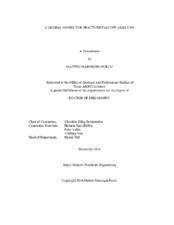| dc.description.abstract | The reservoir permeability is an essential input for the optimum design of modern hydraulic fracture treatments, which are undeniably the crucial technology involved in the development of tight and/or unconventional gas reservoirs. The fracture geometry and pumping execution, as well as the well architecture, can be designed to maximize the well productivity, provided the reservoir permeability is known, but in tight formations estimation of permeability and pressure can be impractical or even impossible to determine by conventional pressure buildup transient tests because no flow will occur without hydraulic fracture stimulation.
Various authors have shown how fracture calibration tests, intended for the final fracture treatment calibration (i.e. estimation of closure stress, leakoff coefficient and fracture fluid efficiency) can be used to estimate reservoir permeability as well. However, all the proposed techniques depend on specialized plots that are designed to show a straight line for a portion of the data, from which parameters are determined either from the slope of the line or from its endpoints, and there is a risk that apparent straight lines may lead to erroneous results, particularly when the absence of late time pseudo-radial flow data is ignored or not recognized.
This dissertation introduces a new global model for the before-closure and after-closure analysis of the pressure falloff following a step-rate or constant rate fracture calibration test, using a single log-log diagnostic plot, as common practice within the pressure transient analysis literature. This model provides a complete assessment tool that allows quantification of all fracture parameters (closure stress, closure time, fracture fluid efficiency, leakoff coefficient and estimate of the induced fracture geometry) as well as reservoir permeability and formation pressure, provided that enough time is allowed for the falloff to reach pseudo-radial flow regime. Both oil and gas reservoirs can be effectively studied.
Another major advantage provided by this approach is that this model can be used to optimize a priori the design of the fracture calibration test that would allow determination of all the involved parameters, including reservoir permeability.
Field data will be used to validate the model and demonstrate its added value over current interpretation methods. | en |


